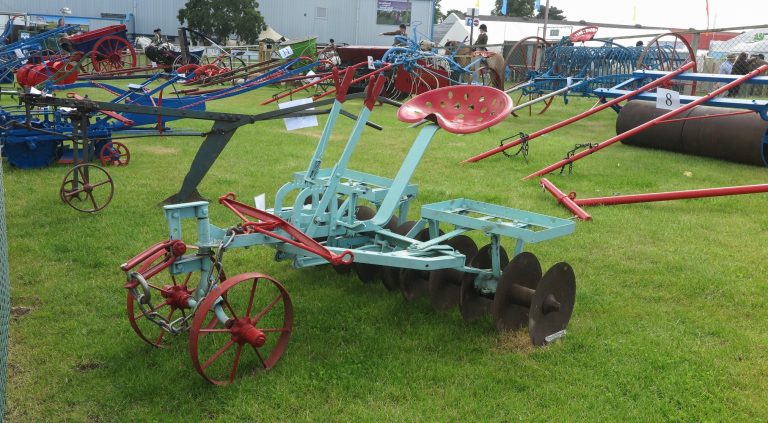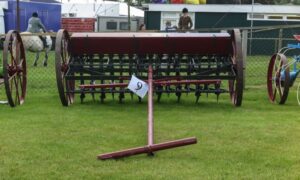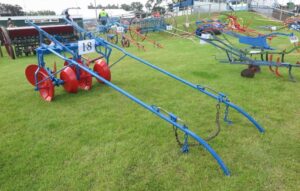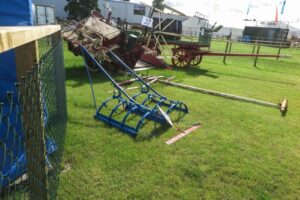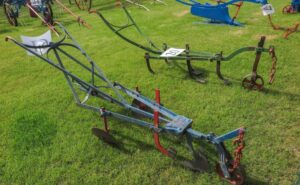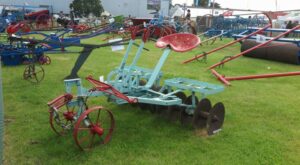What was being exhibited at the Highland Show in 1914?
In the week of the Highland Show newspapers in Scotland published extensive accounts of what was being exhibited in the implement department as well as the awards to the livestock classes. They provide an invaluable account of what was being exhibited, as well as developments in implements and machines and what the activities of the key makers. They also note key trends, as well as innovations that were being made.
The Scotsman of 14 July 1914 provided a detailed description of what was at the show. It is worth quoting at length:
“The Highland Show
A promising prospect
Exhibition of implements
Progress in agricultural engineering
There is nothing in the implement section of the show on this occasion that could be described is strikingly novel, and manufacturers having learned the lessons of previous failures, there is in the same time an absence of anything of a freakish order. The whole display suggests solidity, progress having been continued along well-established lines rather than new avenues, but a steady all-round advance has nevertheless been made. A broad view of the implement yard illustrates the extent to which engineering achievement in other fields, perhaps most notably in regard to the internal combustion engine, is gradually being applied in the domain of agriculture. The future of the self-propelled agricultural vehicle is by no means certain. Its construction offers many difficulties in the way of high power combined with light weight and small initial and working costs, but already some very practical machines have been put forward. In the “motor yard” of the show, which is situated at the entrance gate, and is divided off from the general implement section and the showyard proper by the river Teviot, there is only one example of the motor cultivator, but it is of a fairly representative. At the “Royal” Show at Shrewsbury there were nine exhibits of this nature. The “agrimotor” in question is the “Garrett-Crawley”, shown by Richard Garrett & Sons, Leiston Works, Suffolk, and it is the first implement of the kind yet staged at a “Highland” Show. It is shown fitted with three drills, but it is so adapted that the ploughing fittings can be easily discarded for others suitable for general cultivation work. It is a tractor as well as a plough. Two men are required to work it, a man being still necessary to guide the plough, although it seems possible that in the course of time this extra hand may be dispensed with. That would appreciably enhance the economical qualities the machine already possesses. The engine is a 45hp four cylinder one, and the working costs are reckoned at something like 1s 6d per acre. The cost of the machine is £250. Superheated steam tractors are another feature of the motion yard, and side by side with the agricultural motor Messrs Garrett show three excellent types of varying power. A “three tonner” is fitted with solid rubber tyres, single in front, and a guarantee of 10,000 miles is given with these tyres, a general use of which on big commercial vehicles would add greatly to the peace of the town dweller.
Messrs John S. Millar & Son, engineers, Annan, have as their principal exhibit the automatic cream separator with which, as a new implement, they gained a silver medal at the Royal Show at Shrewsbury. In no department of the farm has the application of mechanical power been greater within the last year or two than in the dairy, and. This exhibit of Messrs Millar’s represents a line in which there has been keen competition among manufacturers. This separator is driven by 1/3 hp engine. It is crankless and gearless, and the speed is very even. It is adaptable for small and large farms-small enough for five cows, and large enough to separate 170 gallons an hour. The weight of the machine is 150lb, and the working costs are as low as 1 1/2d an hour running under full load. The engine may also be used to operate a churn, washing machine &c. the separator is of the disc bowl type, with a patent device by which the milk supply may be shut off while the bowl is at full speed. In addition, several windmills are to be seen on this stand, together with three types of pumps.
Mr R. G. Garvie, Aberdeen, has his usual display of thrashing and other types of agricultural machinery. The principal implement is a 3-feet wide threshing and finishing machine, which works at high speed and with double blast, and is fitted with a screen for small seeds. “Top finish grass ready for the market without further dressing” is its purpose. A 12hp oil engine for driving purposes is shown in conjunction with it. Two smaller types of thrashers are shown driven by petrol engines, and a hand and foot thrashing machine and two types of sowing machines also find places on the stand.
Messrs Alley & MacLellan, Polmadie Works, Glasgow, confine their exhibit to only one feature, and that a peculiarly British product, and one in which home manufacturers at the present time lead the world. They stage a large steam motor waggon of their own design and construction, suitable for a variety of purposes, and giving economical returns.
Mr Daniel Douglas, Perth, also has only one exhibit-a 4 feet fixed double blast thrashing machine, of improved type, for finishing corn for the market.
The Bon-Accord Engineering Company, Aberdeen, stage a 9hp oil engine, adaptable to various forms of farm work, and also two thrashing machines, one 21 inches wide and the other 30 inches wide. Their comprehensive collection includes an artificial manure distributor, a wire strainer, a liquid manure or water-pump, and a hay collector of handy type.
Two sizes of the “Annan” oil engine are shown by Messrs D. H. & F. Reid, engineers, Ayr, the smaller size being combined with a. pump for the supply of water to farms and estates, and the smaller giving 5 1/2b.h.p. at low speed. An interesting feature of their stand is the “Arno” milking outfit, suitable for a dairy of fifty cows.
Messrs Barclay, Ross & Tough, Aberdeen, have a nice collection of thrashing, dressing and finishing machines of standard type, as well as hand-thrashers, winnowers, and cultivators. Typical examples of some of their agencies are also shown.
Messrs P. & R. Fleming, Glasgow, one of the most prominent stands on the grounds by reason of its size, as well as by its varied nature, show a Hornsby oil engine driving a Richmond & Chandler grist mill, and a small “Associated” petrol engine driving a “Phoenix” potato dresser, an implement which has found considerable favour in the North. A new implement shown for the first time at the “Highland” is the Norfolk farmyard manure spreader, a machine which can be attached to the back of an ordinary farm cart, or can be loaded and driven to the field. A specimen of the Ransome potato digger is shown in motion, and demonstrates the easy working of the modern digger over the old fixed pattern. Rick lifters, potato sprayers, hay collectors, and numerous other implements combine to make a capital exhibition.
Messrs John Wallace & Sons (Limited), Glasgow, show a varied selection of farm implements and machinery. Among the items on their stand are several mowers and reapers of handsome appearance and the “Reliance” manure distributor, which is one of the most up-to-date machines for the distribution of artificial manures. It is only offered to the public this year for the first time. Potato diggers, potato planters, combined drill ploughs, and manure sowers, ploughs &c, complete a very representative display.
Windmills and towers, rick lifters, hay collectors, &c are shown by Messrs William Dickie & Sons, East Kilbride, the display including a new patent rick-lifter for either horse or hand power.
A stand of local interest is that of Messrs D. M. Wallace & Sons, Bowmont Engine Works, Kelso. It is small, but contains two useful specimens, one a massive threshing machine, with a 48 in by 22 in drum, and the other a 19-21b.h.p. oil engine made by Allan Brothers.
Another leading Scottish firm, Messrs john Wallace & Sons (Limited), Dennistoun, Glasgow, include in their exhibit mowers and reapers of improved type, while their cultivators are representative of their most popular designs. Sargeant’s patent manure distributors occupy a prominent place on the stand, together with samples of the Wallace binder, combined drill plough and manure sowers &c and various types of ordinary ploughs.
Messrs Allan Brothers, Aberdeen show five oil engines of different horse-power, but all of the improved lampless type, specially designed for agricultural purposes, and to work with any brand of oil.
Among other Scottish firms in the ordinary farm implement section, a prominent place is taken by Messrs J. & R. Wallace, Castle Douglas, who have enjoyed a reputation for some time past on account of their patent milking machine, which is shown replete with vacuum pump, tanks, can, and set of motors with connecting tubes. They also exhibit three forms of manure distributors.
Messrs john McBain & Sons, Chirnside, have a good display of windmills and pumps, root cutters, sheep hacks, carts, &c.
Stationary oil engines, horizontal and vertical, suitable for all classes of power work, and operating equally well on petrol and paraffin, are the only products shown by Messrs Alexander Shanks & Son, Dens Iron Works, Arbroath.
Messrs Telfords (Limited), Glasgow, have an interesting and thoroughly comprehensive display of dairying appliances, including pasteurizers, rotary pumps, separators &c.
Mr Charles Weir, Strathaven and Glasgow, has a comprehensive thrashing mills, petrol engines, churns, rick lifters, hoes, curd mills &c.
Messrs A. & J. Main & Co., Edinburgh, occupy a prominent place with a large collection of Deering harvesting machinery, comprising the now famous ball and roller bearing “Ideal” binders. It is claimed for the Deering “Ideal” binder that it is the lightest running grain harvester on the market. Much of the light draft is due to the ball and roller bearings. They are made of special quality of steel, and they take up the wear of the moving parts without perceptibly wearing themselves. They are also shown the “Ideal” two-horse and one-horse mowers, the latter being well adapted for the use of hill farmers and dairymen, and hay rakes and tedders. There is also displayed here rick lifters, rick stands, manure distributors, potato diggers, potato sorters; and further variety id given to the display by an assortment of sheep turnip cutters, sheep corn bin, sheep wire netting, and petrol engines.
Messrs Alexander Balloch & Sons, Manderston Street, Leith, have an attractive stand of well-finished examples of their leading specialities. Their famous patent disc drill scarifiers occupy a prominent position. The machine is suitable for turnips, mangolds, carrots, beans, &c and can be adjusted to suit the various stages of the crops. There are also exhibits of drill scarifier with side-lands arrangement and hoeing attachment.
Messrs J. Bisset & Sons (Limited), Blairgowrie, have on view three of their patent Bisset binders, which it is claimed are light in draught, easy to handle in working and durable. One of the principle features of this type. Of binders is that the binder attachment has been lengthened, and has a greater transverse than ordinary. This is an advantage in tying long crop. The Bisset straw trusser, with simple and effective knotters, and with simple adjustable hoppers, is also a notable exhibit.
Messrs Alexander Jack & Sons (Limited), Agricultural Implement Works, Maybole, Ayrshire, have a large stand on which prominence is given to several “Imperial” artificial manure distributors to sow in different widths up to 9ft 4 in. These implements distribute all kinds of artificial manures, and each manure is supplied with five change speed pinions of wide range. The firm also make a speciality of potato raisers, carrying six forks. The forks, though centrally driven, do not move in a circle, but give a good hand-fork action.
Messrs J. D. Allan & Sons, Murthly, have on view a variety of appliances of their well-known manufacture, including their patent dung spreader, potato diggers, and a number of coup and other carts.
In addition to a number of drill ploughs, grubbers, and scarifiers, Messrs Thomas Hunter & Sons, Maybole, show an “Excelsior” manure distributor, features of which are that it is worked by an endless chain, and will distribute very wet manure.
Messrs Robert Begg & Sons, Dalry, Ayrshire, have among their exhibits six chill ploughs, two with sett irons, as well as a special double-furrow plough, and an improved drill plough, with marker.
Messrs Kemp & Nicholson, Stirling, display a number of specimens if their drill grubbers, horse hay or stibble rakes, harrows, carts and lorries. Three double-action leverage hay and straw balers with steel framing, on this stand, should receive close attention.
Messrs A. Newlands & Sons, St Magdelene Engineering Works, Linlithgow, make a feature of drill grubbers, with renewable plates, which go into the hardest ground. A side lever on the wheels regulates the depth. Besides a number of ploughs and cultivators, the firm also display a self-acting rake and a “Parmeter” flexible harrow for taking fog out of pasture.
On the stand set apart for Messrs Thomas Brown & Sons, Duns, are to be seen the “Cammo” combined reaper and mower, turnip cutters and slicers, an improved potato sorter with elevator, corn drills and cultivators, including a thirteen double-tined cultivator with front swivel wheel.
The outstanding feature of the stand occupied by Mr David Wilson, Bridgeside Implement Works, East Linton, Prestonkirk, is a potato digger, which, it is claimed, will raise the whole crop undamaged, and leave it in narrow rows. The outer exhibits include a potato cleaning and sizing machine, a washing machine, and potato sprouting boxes.
A large assortment of farm and horticultural implements are exhibited by Messrs Thomas Gibson & Son, Bainfield Iron Works, Edinburgh, who occupy one of the largest stands in the yard. They have on view about 150 different iron and steel articles of their own manufacture. Among the outstanding exhibits are two iron corn rick stands, one 14 feet diameter and the other 10 feet, with improved air bossings, the purpose of which is to enable farmers to take in corn in wet weather. There are exhibited carriage, and field gates of every description, ornamental wire archways, and a variety of shelter tents, ornamental hurdle and garden fencing, and a large assortment of horticultural requisites.
Among a variety of lawn mowers on this stand allotted to Messrs Alexander Shanks & Son (Limited) Dens Iron Works, Arbroath, the outstanding article on view is a 30 inch motor lawn mower, complete with grass box.
A wind engine and water wheel are exhibited by Mr D. T. Paterson, Duns.
A number of the “Sherriff” corn drills, a market gardener seeder, with adjustable coulters, for all kinds of market gardens, seeds and grains, fitted with patent tempered steel delivery brushes and markets, and a variety of steel frame sowers are among the more prominent exhibits displayed by Messrs Thomas Sheriff & Co., West barns, Dunbar. Of special interest is the “Small Holdings” combined drill and broadcast sower, with adjustable coulter. This is a handy machine, which sows all kinds of small seeds and grain and grass seeds.
Various types of binders, including a “Milwaukee” special light draft binder, combined reapers and mowers, general purpose ploughs, improved potato diggers, and turnip and mangold sowers are among the principal exhibits on the stand occupied by Mr George Henderson, Kelso Foundry, Kelso. A number of cattle and pig troughs are also shown.
Messrs Wm Wilson & Son, Crosshouse, Ayrshire, exhibit a patent horse fork and crane; and a blowing, winnowing, and screening machine for cleaning grain and grass seed, with a special riddle for taking runches out of oats.”
